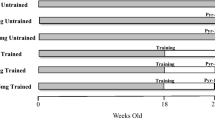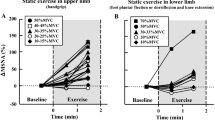Abstract
We investigated the effects of exercise training on heart rate variability (HRV) and myocardial adrenergic and muscarinic receptors in rats. Exercise training induced a decrease in body mass while ventricular size remained unchanged, a development we considered as a relative cardiac hypertrophy. In addition, there was a reduction in the density of myocardial β1-adrenergic receptors. These structural changes were associated with functional adaptations, as illustrated by the increased response of the sinus node to sympathetic blockade.
Similar content being viewed by others
References
Barbier J, Rannou-Bekono F, Marchais J, Berthon PM, Delamarche P, Carré F (2004) Effect of training on β1, β2, β3 adrenergic and M2 muscarinic receptors in rat heart. Med Sci Sports Exer 36:949–54
Barnard RJ, Corre K, Cho H (1976) Effect of training on the resting heart rate of rats. Eur J Appl Physiol 35:285–89
Basset A, Blanc J, Messas E, Hagege A, Elghozi JL (2001) Renin-angiotensin system contribution to cardiac hypertrophy in experimental hyperthyroidism: an echocardiographic study. J Cardiovasc Pharmacol 37:163–72
Böhm M, Dorner H, Htun P, Lensche H, Platt D, Erdmann E (1993) Effects of exercise on myocardial adenylate cyclase and Gia expression in senescence. Am J Physiol 264:H805–H814
Bolter CP, Hughson RL, Critz JP (1986) Intrinsic rate and cholinergic sensitivity of isolated atria from trained and sedentary rats. Proc Soc Exp Biol 144:364–67
Carré F, Maison-Blanche P, Ollivier L (1994) Heart rate variability in two models of cardiac hypertrophy in rats in relation to the new molecular phenotype. Am J Physiol 266:H1872–H1878
Davy KP, Miniclier NL, Taylor JA, Stevenson ET, Seals DR (1996) Elevated heart rate variability in physically active postmenopausal women: a cardioprotective effect? Am J Physiol 271:H455–H460
De Schryver C, Mertens-Stryhagen J (1972) Heart tissue acetylcholine in chronically exercised rats. Experientia 31:316–21
Favret F, Henderson KK, Clancy RL, Richalet JP, Gonzalez NC (2001) Exercise training alters the effect of chronic hypoxia in myocardial adrenergic and muscarinic receptor number. J Appl Physiol 91:1283–288
Gallagher K, Raven P, Mitchell J (1999) Classification of sports and the athlete’s heart. In:Williams R (ed) The athlete and heart disease. Philadelphia: Lippincott Williams and Wilkins, pp 9–1
Gritzali F (1988) Towards a generalised scheme for QRS detection in ECG waveforms. Signal Processing 15:183–92
Hardouin S, Mansier P, Bertin B, Dakhly T, Swynghedauw B, Moalic JM (1997) β-adrenergic and muscarinic receptor expressions are regulated in opposite ways during senescence in rat left ventricle. J Mol Cell Cardiol 29:309–19
Huonker M, Halle M, Keul J (1996) Structural and functional adaptations of the cardiovascular system by training. Int J Sports Med 17:S164–S172
Japundzic N, Grichois ML, Zitoun P, Laude D, Elghozi JL (1990) Spectral analysis of blood pressure and heart rate in conscious rats: effects of autonomic blockers. J Auton Nerv Syst 30:91–00
Kobusiak-Prokowicz M, Negrusz-Kaweka M (2003) Heart rate variability in patients suffering from essential hypertension with different mapping of left ventricle. Pol Arch Med Wewn 109:349–57
Levy MN, Yang T, Wallick DW (1993) Assessment of beat to beat control of heart rate by the autonomic nervous system: molecular biology techniques are necessary, but not sufficient. Cardiovasc Electrophysiol 4:183–93
Levy W, Cerqueira M, Harp G (1998) Effect of endurance training on heart rate variability at rest in healthy young and older men. Am J Cardiol 8:1236–241
Mangin L, Swynghedauw B, Benis A, Thibault N, Lerebours G, Carré F (1998) Relationships between heart rate and heart rate variability: study in conscious rats. J Cardiovasc Pharmacol 32:601–07
Mazzeo RS, Brooks GA, Horvath SM (1984) Effects of age on metabolic responses to endurance training in rats. J Appl Physiol 57:1369–374
Niess A, Roecker K, Mayer F, Heitkamp HC, Dickhuth HH (1996) Effect of combined parasympathetic and sympathetic blockade on left ventricular relaxation at rest and during exercise in trained and untrained men. Int J Sports Med 17:S180–S183
Nylander E (1981) Effect of betaadrenergic receptor blockade on development of training-induced bradycardia in rats. Acta Physiol Scand 112:449–54
Reland S, Ville N, Wong S, Gauvrit H, Kervio G, Carré F (2003) Exercise heart rate variability of older women in relation to level of physical activity. J Gerontol Biol Sci 58A:585–91
Rozec BJ, Noireaud JN, Trochu L, Gauthier C (2003) Place of β3-adrenoceptor subtypes in the regulation of the cardiovascular system. Cardiovasc Res 96:905–13
Safa-Tisseront V, Ponchon P, Laude D, Elghozi JL (1998) Contribution of the autonomic nervous system to blood pressure and heart rate variability changes in early experimental hyperthyroidism. Eur J Pharmacol 352:247–55
Seals DR, Taylor JA, Ng AV, Esler MD (1994) Exercise and aging autonomic control of the circulation. Med Sci Sports Ex 5:568–76
Author information
Authors and Affiliations
Corresponding author
Additional information
* Drs. Barbier and Reland contributed equally to this work
Rights and permissions
About this article
Cite this article
Barbier*, J., Reland*, S., Ville, N. et al. The effects of exercise training on myocardial adrenergic and muscarinic receptors. Clin Auton Res 16, 61–65 (2006). https://doi.org/10.1007/s10286-006-0312-0
Received:
Accepted:
Issue Date:
DOI: https://doi.org/10.1007/s10286-006-0312-0




